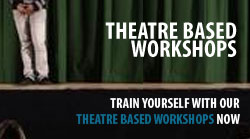Neuro linguistic programming gives us skills to understand the patterning of people and thus the method to work effectively with people around us. Understanding patterning of people goes a long way in management and our day to day personal interactions with people.
 We are all aware success in business and personal lives have always come through building great relationships. If one were to look at the value system of every organization we reckon with, people have always been given prime importance. Ironically this value is also a great cause of worry for all organizations. Issues pertaining to man management have resulted in deterioration of healthy an environment and thus the overall performance in organizations. Often remedial measures do not identify the root cause of the issue, and time and energy is spent in a futile way. In our personal lives we are all aware of the problems that come up in interactions at home and outside.
We are all aware success in business and personal lives have always come through building great relationships. If one were to look at the value system of every organization we reckon with, people have always been given prime importance. Ironically this value is also a great cause of worry for all organizations. Issues pertaining to man management have resulted in deterioration of healthy an environment and thus the overall performance in organizations. Often remedial measures do not identify the root cause of the issue, and time and energy is spent in a futile way. In our personal lives we are all aware of the problems that come up in interactions at home and outside.
The solution lies in the presupposition of Neuro linguistic programming that each person is unique, however we all expect others to think and act the way we want. Hence effective man management starts with changing ourselves and adapting to the patterns of the way people think, which is also called building rapport, and most of the times it happens unconsciously.
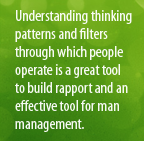 Understanding thinking patterns and filters through which people operate is a great tool to build rapport and an effective tool for man management. Thinking patterns are the way in which people access internal resources, which are conditioned or programmed over the years. However once you know your pattern and that of the others you can change them and run them to achieve the desired outcome. Thinking patterns essentially operate on our five senses i.e. visual, auditory, feeling, smell and taste. This can be easily understood by saying the word ‘coffee’.
Understanding thinking patterns and filters through which people operate is a great tool to build rapport and an effective tool for man management. Thinking patterns are the way in which people access internal resources, which are conditioned or programmed over the years. However once you know your pattern and that of the others you can change them and run them to achieve the desired outcome. Thinking patterns essentially operate on our five senses i.e. visual, auditory, feeling, smell and taste. This can be easily understood by saying the word ‘coffee’.
For some people this word would generate a picture of a cup of steaming hot coffee, they essentially belong to the visual category. For a certain category of people the taste or smell of Coffee gets activated thus their gustatory or the olfactory sense is predominant. For the rest it could either generate the sound of cups and saucer or sound of coffee being poured in a cup or for the others a refreshing feeling or any other sensation that the coffee could give. They belong to auditory and the kinesthetic type respectively. Interestingly, the language that people use also is in line with the thinking patterns.
Let’s look at an example of a statement below.
This idea looks good
This idea sounds good
This idea feels good
This idea leaves a good taste
All our experiences are stored in form of five senses and the resulting language which people use to describe them are in line with the sense that is predominant within the person. This explains the fact why people use different words in languages. Interestingly, people use same type of word patterns while interpreting the experience in different languages.
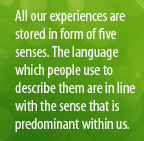 The fact that experiences are stored in terms of five senses gives us ways to use them the way we want. For example, let us analyze an experience for a visual person. The experience is most of the time a visual recall and it has color, it could be moving or still and has a measure of clarity. This image could be big or small. The intensity of the experience is a function of these parameters. By using certain techniques we can vary these parameters and change the experience.
The fact that experiences are stored in terms of five senses gives us ways to use them the way we want. For example, let us analyze an experience for a visual person. The experience is most of the time a visual recall and it has color, it could be moving or still and has a measure of clarity. This image could be big or small. The intensity of the experience is a function of these parameters. By using certain techniques we can vary these parameters and change the experience.
Similarly, auditory parameters like tone and volume can be changed to vary the experience of an auditory person. Kinesthetic parameters could be strength, location, temperature, etc. for people who operate through feelings. The statements like ‘loud and clear’ or ‘cool’ are an expression of how the recall is. By varying these parameters our resulting behaviour also changes. You could change undesirable memories in relationships or change your language patterns to build immediate rapport.
Another pattern which affects an experience is whether you are associated or dissociated with it. The ability to preferentially use any of these can be a great resource. We are in unresourceful states when we are in an associated state with an unpleasant memory. By varying the parameters of five senses and by getting dissociated we can get into a resourceful state immediately. Associated states for pleasant experiences can be a great motivational tool too. Some people do this unconsciously and thus are in a resourceful state even in the most trying situations. People with the habit of worrying operate in associated states and envy the quality people with dissociated pattern have and often term them ‘thick skinned.
 Then we have the pattern of moving towards and moving away from. Again people exercise one of these predominantly. Moving away people keep looking for problems or different options in a given situation and find it difficult to zero down on a decision. Moving towards pattern does not look at options and is a pattern of compulsive decision makers. There exists a great mismatch here and leads to stress in teams.
Then we have the pattern of moving towards and moving away from. Again people exercise one of these predominantly. Moving away people keep looking for problems or different options in a given situation and find it difficult to zero down on a decision. Moving towards pattern does not look at options and is a pattern of compulsive decision makers. There exists a great mismatch here and leads to stress in teams.
However these two patterns complement each other in decision making and a team should thus have a combination of such people for obvious reasons. To manage people with moving away pattern a moving towards patterned person should work on style of moving away. This would put pressure on the moving away patterned person to move towards making a decision. A classic example of this is, we often use the expression of disgust like “we are not arriving at any conclusion so do what you please.” Suddenly people start responding in a decisive way.
There is a pattern called big chunk or global thinking and small chunk or detailing. Certain set of people work on an outline of the idea and find it very boring when it gets to detailing. And then again some people work only on specifics and detail. Imagine a boss who is small chunk and a subordinate who is big chunk. Needless to say meetings would not end in a happy state. So to manage the situation, either of them should change the pattern and results would be immediate and pleasant. However again it is important to understand when you address any issue both the pattern complement each other.
 The pattern of looking for matching results in some people, recalling experiences similar to one under consideration to preempt outcome. And then there are some with a mismatch pattern who look for dissimilarity. Just imagine how difficult the situation gets and then we say our thinking is ‘poles apart’. However it is important to understand that looking at only matches or mismatches cannot get you the success. That’s why we ‘weigh pros and cons’ of the situation.
The pattern of looking for matching results in some people, recalling experiences similar to one under consideration to preempt outcome. And then there are some with a mismatch pattern who look for dissimilarity. Just imagine how difficult the situation gets and then we say our thinking is ‘poles apart’. However it is important to understand that looking at only matches or mismatches cannot get you the success. That’s why we ‘weigh pros and cons’ of the situation.
When it comes to accepting ideas individuals are either internally referenced or externally referenced. Internally referenced people use their own internal feelings, voices and images as evidence of fulfillment. Externally referenced people rely on external factors for decision making. By knowing this we can easily work on a strategy to influence a decision; a great tool in situations requiring convincing.
Our experiences are also sorted through patterns or our filters like working on situation based on past, present or future. Thus you will find people mostly using past experience or sensing current situation to arrive at any decision; while you will find some in a continuous planning process. These are the people who work in future mode always.
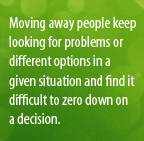 It is important to understand that there is nothing right or wrong in the thinking process. It is essentially the way you are and it can be used as an advantage by understanding the pattern of the other people viz. yours and then look at a strategy to build fruitful relationships. Win-win techniques are an implementation of these patterns. By understanding patterns of people, organizations are effectively using NLP to define roles for the people within.
It is important to understand that there is nothing right or wrong in the thinking process. It is essentially the way you are and it can be used as an advantage by understanding the pattern of the other people viz. yours and then look at a strategy to build fruitful relationships. Win-win techniques are an implementation of these patterns. By understanding patterns of people, organizations are effectively using NLP to define roles for the people within.
You can use these patterns to manage your internal dialogue consciously. By working on your patterns you can change the experience of situations and people. This would thus have a direct impact on your behaviour and thus the resulting outcome. By managing your internal dialogue you can hold your memories in a way that supports the person you want to be. In short, understanding thinking patterns is a great way to build relationships. After all successful relationships can be built one on the basis of great understanding. It is thus evident that the interactions amongst people are a function of how thinking patterns match.
A conscious effort towards understanding these can help you become successful team leaders and also enrich your personal lives.
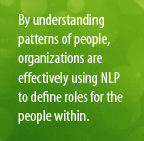 NLP tip of the day: Managing your thoughts
NLP tip of the day: Managing your thoughts
Think of a memory that you hold which is disturbing you
Close your eyes and relax and visualize the memory
Check it in terms of the size of the picture, whether it is still or moving, framed or unframed and any sounds associated with it
Add a different or funny music to it and paint the picture of the main incident as a colorful photograph
Open your eyes and check the experience for a different feeling
If you so desire to further change, repeat with some other combination of type of frame, music and color
Be in a relaxed state of mind when you do this exercise; kinesthetic people will have to focus to visualize and then they would find it easy
This can be used as a tool to get rid of small worries that hamper our work in daily life and stress us out.










